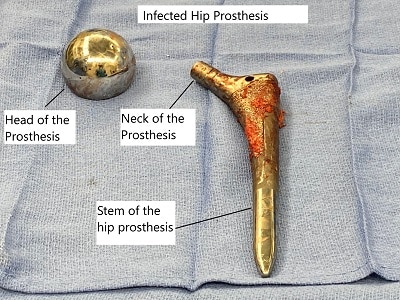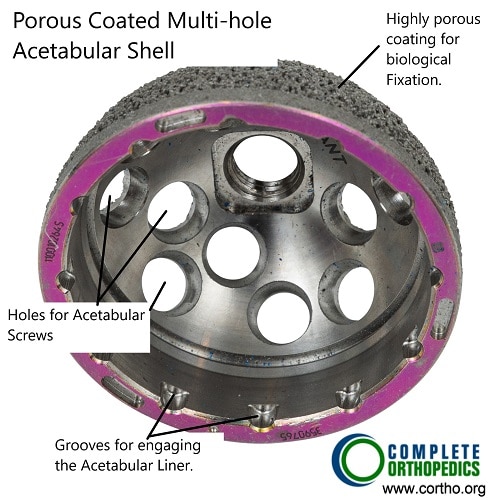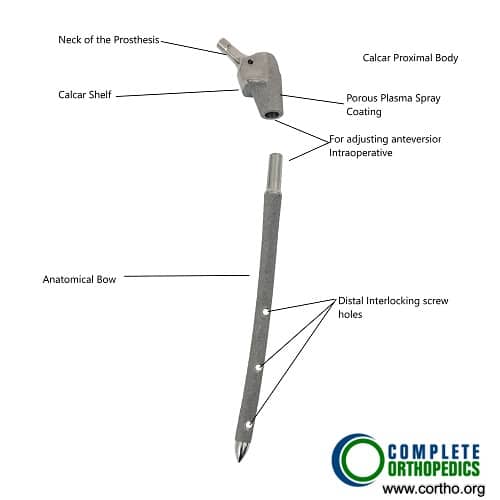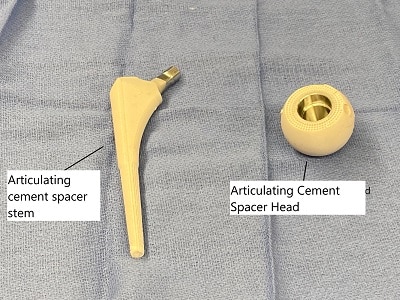Revision Hip Replacement
Revision hip replacement is a surgery to replace the components of a Total Hip replacement. Hip is a large ball and socket joint which may be damaged due to arthritis or other cause. The surgery involves replacing the parts forming the Hip joint with prosthetic/man made parts.
Total hip replacement is one of the most successful surgeries in modern medicine. On an average, hip replacement surgery may last for 15-20 years or more. Due to various biological and mechanical reasons the parts may fail, requiring a surgery involving removal of implant and replacing them.
Revision hip replacements are usually more complex surgeries than primary total Hip replacements requiring extensive planning and use of special implants. The ultimate goal however remains the same as of primary replacement. The aim of providing pain free mobility so that the patients can return to activities they enjoy.

Prosthetic components removed due to failure.
Components of Total Hip Replacement
- Acetabulum cup made of metal alloy or ceramic. It is is fixed with screws or press-fitted in the socket forming the Hip joint after removing damaged
- A special form of highly durable plastic called polyethylene is placed in the socket to allow smooth gliding
- A stem made of metallic alloy is inserted in the upper part of the thigh bone (femur). The stem may be press-fit or fixed using a special form of bone cement.
- A prosthetic head made of metal alloy or ceramic is placed on the stem replacing the natural head of the femur.

Acetabular shell with multiple screw hole options.
The acetabular shell is usually press fitted in the acetabular cavity. The acetabular cavity is prepared by reaming the cavity that allows new bone to grow into the outer porous coating of the acetabular shell. The multiple screw options are advantageous in revision surgery.

Prosthetic femoral head and acetabular liner
The acetabular liner made of highly cross linked polyethylene fits in the acetabular shell and provides a smooth surface for the prosthetic head to rotate in the cavity. The prosthetic head may be made of ceramic or cobalt chromium alloy.

Fully porous coated long femoral stem with anatomical bow.
During revision surgery, a fully porous coated femoral stem is usually used for a better stability of the component. The stem is also longer than the primary prosthesis to provide more stability. Other types of stems may be used that may have detachable upper and lower parts (modular stems).
Causes of Component Failure
Like any mechanical device, the components of hip replacement surgery can fail over time. Number of factors can contribute to their failure and need for revision surgery.
Wear and Tear : The implant (femoral stem and acetabulum cup) must be firmly fixed to the underlying bone. This is achieved either by the use of bone cement or the implant is press fit. Press fitting allows bone to grow onto the implant.
The failure of bone to grow on the implant or loosening of bone cement weakens the fixation. This may lead to chronic pain with decrease in mobility.
Younger patients with a total Hip replacement outlive the lifespan of the implant requiring revision. Additionally, individuals who are overweight and engaging in high impact activities require a revision surgery sooner. This is due to excessive forces acting about the joint loosening the fixation.
The plastic liner which is made of high quality polyethylene wears out over time giving out tiny particles. These are attacked by the body’s immune system recognizing them as foreign bodies causing inflammation. The immune cells fighting the plastic breaks also attack the healthy bone which leads to loosening of implant known as osteolysis.
Infection : Every surgery carries a risk of infection which may occur immediately or occur in several months or even years. Infectious organisms accumulating in and around the prosthesis cause the implant to become loose same fail.
Obese patients with diseases such as diabetes are at an added risk of infection. Infectious bacteria can enter into blood from distant sites such as teeth and accumulate forming an abscess around the prosthetic joint. Symptoms usually are pain or even a draining abscess from the joint.
Trauma : Injuries sustained to the hip during a trauma caused by fall or accident can cause loosening of prosthesis. There may be a fracture of the bone around the implant (periprosthetic fracture) or rarely breakage of the metal implant itself. The revision usually requires use of special implants depending upon the amount of remaining bone.
Dislocation : For the joint to function the ball must remain in the socket at all times. Dislocation occurs when the ball pops out of the socket due to trauma or certain positions of the artificial joint. Proper alignment of the components and balancing of forces by muscles and tendons is important.
Once dislocated the joint becomes more prone to recurrent dislocations as muscles and tendons around the joint get damaged. This may warrant a revision surgery to properly align the prosthetic components preventing dislocation.
Management
Revision hip replacement is a complex Surgery requiring special implants work increased surgery and recovery time. Usually more number of investigations are needed. The patient may be subjected to blood tests and imaging studies (X-ray, CT scan, MRI, Bone scan). In case the surgeon suspects an infection, a joint aspiration may be done to rule out or confirm the infection.
The surgical procedure on the day of surgery after anesthesia is more complex than primary replacement. The surgeon gets an access to the joint through the same incision or a different one. Careful examination of the soft tissues is done to look for infection and examine the components which are loose.
Only the plastic liner and head of stem is replaced in some cases. This is done in case of the firm contact of acetabulum cup and femoral stem. In case of loose implant, they are extracted carefully trying to preserve the bone. Sometimes a controlled fracture may be done to gain access to the implant for removal.
Specialized implants are used to recreate the Hip joint. It may sometimes require bone graft (from deceased compatible ) and metals to augment/compensate for the lost/damaged bone.

Modular femoral stem
A modular prosthetic stem allows the surgeon to compensate for excessive bone loss during extraction of the primary component. The modular stem may consist of holes for screw fixation and fully porous coating for bone ingrowth. The upper part of the prosthesis is designed to transfer load to the stronger inner of the bone.
In case of infected prosthesis, the revision surgery becomes more complicated. Decision regarding the surgery is made after assessing the duration and severity of the infection. Usually a two stage surgery is performed where in the first stage the infected implant is removed.

Articulating cement spacer.
The Hip joint is thoroughly washed and a cement spacer is introduced which is impregnated with antibiotics. After clearance from infection in a few weeks a second surgery is performed removing the spacer and introduction of new implants.
In a selected few cases a single stage surgery may be performed depending upon the severity of infection. Infected protestors requiring revision usually remain a long time on iv antibiotics with a very prolonged recovery period.
Recovery
Revision hip replacements usually have a prolonged recovery period depending upon the cause of revision. Daily activities such as cooking, shopping, bathing, laundry, driving are limited for several weeks. Patients usually walks work an aid of crutches/walker with precautions restricting certain activities.
Full recovery and return to activities the enjoys takes about 6 months. Regardless most patients enjoy pain free mobility offered by the surgery allowing them to carry on their daily activities.
Complication
The risk of complications are more in revision hip replacement owing to prolonged surgery time and prolonged recovery period. There are risks of infection, blood clots, pulmonary embolism (blood clots in lung). Additionally there may be damage to nerve/blood vessel or leg lengthening/shortening. There is also a risk of failure of bone to attach to the prosthetic implant and implant loosening.
All the potential complications are discussed by the surgeon with the patient. Certain measures like compression stockings, blood thinners, physical therapy, antibiotics and precautions are undertaken to prevent complications.
Outcome
A greater number of revisions are being performed today successfully. This has lead to pain free hip joint, promising return to activities the patients enjoy. Although the revision surgeries are complex with a prolonged recovery time, long term outcomes are excellent.
Do you have more questions?
What is revision hip replacement surgery?
Revision hip replacement surgery is a procedure performed to replace a previously implanted artificial hip joint that has either worn out, become damaged, or failed for various reasons.
When might someone need revision hip replacement surgery?
Revision hip replacement surgery may be necessary due to factors such as loosening of the implant, infection, fracture around the implant, instability, or wear and tear of the artificial joint over time.
What are the signs that a hip replacement may need revision?
Signs indicating a potential need for revision hip replacement include persistent pain, instability or dislocation of the hip, difficulty walking or bearing weight, and evidence of implant failure on imaging studies.
How is revision hip replacement surgery different from primary hip replacement?
Revision hip replacement surgery is more complex than primary hip replacement as it involves removing the existing implant, addressing any bone loss or structural issues, and then replacing it with a new implant.
What are the risks associated with revision hip replacement surgery?
Risks of revision hip replacement surgery include infection, blood clots, nerve injury, fracture, dislocation, and the need for further revision surgeries in the future.
How long does it take to recover from revision hip replacement surgery?
Recovery time from revision hip replacement surgery varies depending on factors such as the patient’s overall health, the extent of the surgery, and any complications encountered during the procedure. Generally, it may take several months to fully recover.
What is the success rate of revision hip replacement surgery?
The success rate of revision hip replacement surgery depends on various factors such as the reason for revision, the surgeon’s skill, and the patient’s overall health. Generally, success rates are high, with many patients experiencing significant improvement in symptoms and function.
Can all hip replacement implants be revised?
While most hip replacement implants can be revised, some factors such as implant design, fixation method, and bone quality may affect the feasibility and success of revision surgery.
How do I know if I’m a candidate for revision hip replacement surgery?
Candidates for revision hip replacement surgery typically undergo a thorough evaluation by an orthopedic surgeon, including physical examination, imaging studies, and medical history review, to determine the most appropriate course of treatment.
Are there alternatives to revision hip replacement surgery?
Depending on the specific circumstances, alternatives to revision hip replacement surgery may include conservative management with medications, physical therapy, or other non-surgical interventions. However, in many cases, revision surgery may be the most effective option for addressing implant failure or complications.
Will revision hip replacement surgery relieve all of my hip pain?
While revision hip replacement surgery aims to alleviate hip pain and improve function, it may not completely eliminate all symptoms, particularly if there are underlying issues such as nerve damage or extensive bone loss.
What type of anesthesia is used for revision hip replacement surgery?
Revision hip replacement surgery is typically performed under general anesthesia, although regional anesthesia techniques such as spinal or epidural anesthesia may also be used in some cases.
How long does revision hip replacement surgery take?
The duration of revision hip replacement surgery varies depending on factors such as the complexity of the case and any unforeseen complications, but it generally takes several hours to complete.
Will I need physical therapy after revision hip replacement surgery?
Yes, physical therapy is an essential component of rehabilitation following revision hip replacement surgery. A structured exercise program helps improve strength, range of motion, and functional mobility.
What can I expect during the recovery period after revision hip replacement surgery?
During the recovery period, patients can expect to gradually regain mobility and function with the help of physical therapy. Pain and discomfort are common initially but should improve over time
Are there any restrictions on activities after revision hip replacement surgery?
While activity restrictions may vary depending on individual circumstances and the surgeon’s recommendations, patients are generally advised to avoid high-impact activities and heavy lifting to prevent implant failure or complications.
Will I need to take medication after revision hip replacement surgery?
Depending on the individual patient’s needs, medications such as pain relievers, antibiotics, and blood thinners may be prescribed following revision hip replacement surgery to manage pain, prevent infection, and reduce the risk of blood clots.
How often will I need to follow up with my surgeon after revision hip replacement surgery?
Follow-up appointments with the surgeon are typically scheduled at regular intervals following revision hip replacement surgery to monitor healing, assess progress, and address any concerns or complications that may arise.
Can revision hip replacement surgery be performed using minimally invasive techniques?
Minimally invasive techniques may be utilized in some cases of revision hip replacement surgery, depending on factors such as the patient’s anatomy and the complexity of the revision. However, not all cases are suitable for minimally invasive approaches.
What factors affect the success of revision hip replacement surgery?
Factors influencing the success of revision hip replacement surgery include the surgeon’s experience and skill, the reason for revision, the condition of the bone and surrounding tissues, and the patient’s overall health and compliance with postoperative instructions.
Will I need blood transfusions during or after revision hip replacement surgery?
Blood transfusions may be necessary during or after revision hip replacement surgery, particularly in cases where there is significant blood loss. Your surgeon will discuss the potential need for transfusions and address any concerns you may have.
How can I minimize the risk of complications during and after revision hip replacement surgery?
Following your surgeon’s preoperative instructions, maintaining good overall health, and adhering to postoperative guidelines such as activity restrictions, medication regimens, and physical therapy can help minimize the risk of complications and promote a successful outcome.
What should I do if I experience unexpected symptoms or complications after revision hip replacement surgery?
If you experience unexpected symptoms or complications after revision hip replacement surgery, such as increased pain, swelling, fever, or difficulty with mobility, it is important to contact your surgeon promptly for evaluation and management. Early detection and intervention can help prevent further complications and promote optimal recovery.
My name is Dr. Suhirad Khokhar, and am an orthopaedic surgeon. I completed my MBBS (Bachelor of Medicine & Bachelor of Surgery) at Govt. Medical College, Patiala, India.
I specialize in musculoskeletal disorders and their management, and have personally approved of and written this content.
My profile page has all of my educational information, work experience, and all the pages on this site that I've contributed to.

